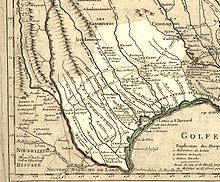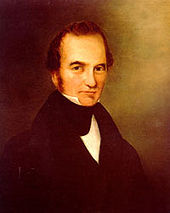Texas
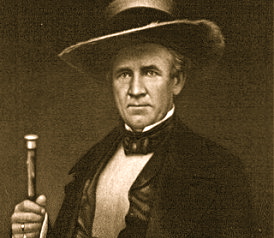
Texas: Colonization to Independence
Timeline of Texas: 1500’s
- (1519) Alonso Alvarez de Pineda, a Spanish explorer, mapped the Texas coastline
- (1528) Alvar Núñez Cabeza de Vaca and crew were shipwrecked near Galveston and began exploration
1600’s
 (1682) The first Spanish mission, Corpus Christi de la Isleta, established near present-day El Paso
(1682) The first Spanish mission, Corpus Christi de la Isleta, established near present-day El Paso- (1685) The French explorer Rene-Robert Cavelier, Sieur de La Salle, landed in Texas by mistake while searching for the mouth of the Mississippi River. He established the colony, Fort St. Louis, in present-day Victoria County
- (1687) La Salle killed by his own men
- (1688) Colonists killed by the Karankawa Indians
1700’s
- (1718) The San Antonio de Valero mission, (the Alamo) founded in San Antonio
- (1731) The civilian settlement, San Fernando de Bexar, established by a group of Canary Islanders
- (1766) The first recorded hurricane in Texas struck near Galveston
1800’s
 (1829) Several groups of Irish immigrants arrived in South Texas
(1829) Several groups of Irish immigrants arrived in South Texas- (1830) The Mexican government passed a law stopping legal immigration into Texas from the United States except in special cases
- (1832) The first bloodshed of the Texas Revolution took place at Velasco
- (1835) The Texas Rangers organization officially established by the provisional government
- (1836) The Texas Declaration of Independence adopted; a 13-day siege of the Alamo by Mexican troops led by Gen. Antonio López de Santa Anna ended with all the remaining defenders killed; about 350 Texas prisoners, including Commander James Fannin, were executed at Goliad; an 18 minute battle led by Sam Houston defeated the Mexican army at San Jacinto; treaties were signed ending the Texas Revolution; the first leaders of the new republic were elected: Sam Houston as president and Lorenzo de Zavala, vice president; the first congress of the Republic of Texas convened
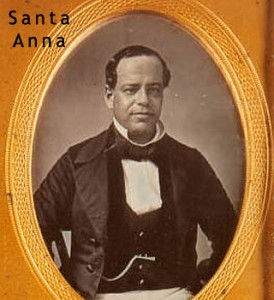 (1837) The Republic of Texas officially recognized by the United States
(1837) The Republic of Texas officially recognized by the United States- (1845) The U. S. Congress passed a “Joint Resolution for Annexing Texas to the United States”; Texas became the 28th state.
- (1846) The Battle of Palo Alto, the first major battle of the two-year Mexican War, took place near Brownsville
- (1848) The Treaty of Guadalupe Hidalgo signed ending the War with Mexico in 1850. Texas gave up its claim to land that included more than half of what is now New Mexico, about a third of Colorado, a corner of Oklahoma and a small portion of Wyoming
- (1861) Texas seceded from the Union; Sam Houston resigned as governor in protest
- (1865) The Battle of Palmito Ranch fought near Brownsville after the official end of the Civil War, as word had not yet reached Texas that the war was over; General Granger traveled to Galveston to announce that slavery had been abolished
- (1865) A proclamation of peace between the United States and Texas was issued
- (1869) A new Texas State constitution adopted
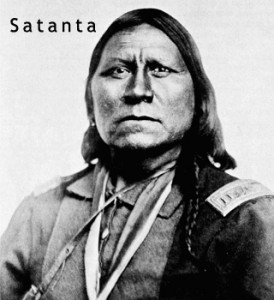 (1871) Seven men in a wagon train were massacred at Salt Creek, about 20 miles west of Jacksboro, by Kiowas and Comanches led by chiefs Satanta, Big Tree, Satank and Eagle Heart
(1871) Seven men in a wagon train were massacred at Salt Creek, about 20 miles west of Jacksboro, by Kiowas and Comanches led by chiefs Satanta, Big Tree, Satank and Eagle Heart- (1884) Fence-cutting problems caused the Texas Legislature to pass a law making fence-cutting a felony
- (1886) A hurricane damaged or destroyed every house in the port of Indianola, which was never rebuilt
- (1888) State capitol in Austin dedicated
- (1894) Oil discovered at Corsicana by workers drilling for fresh water
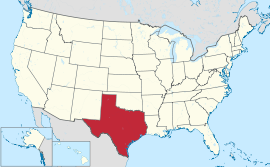 Texas is the second most populous and the second most extensive of the 50 United States, and the most extensive state of the 48 contiguous United States. The name, based on the Caddo word tejas meaning “friends” or “allies”, was applied by the Spanish to the Caddo themselves and to the region of their settlement in East Texas. Located in the South Central United States, Texas shares an international border with the Mexican states of Chihuahua, Coahuila, Nuevo León, and Tamaulipasto the south, and borders the US states of New Mexico to the west, Oklahoma to the north, Arkansas to the northeast, and Louisiana to the east. Texas has an area of 268,820 square miles (696,200 km2), and a growing population of 25.7 million residents.
Texas is the second most populous and the second most extensive of the 50 United States, and the most extensive state of the 48 contiguous United States. The name, based on the Caddo word tejas meaning “friends” or “allies”, was applied by the Spanish to the Caddo themselves and to the region of their settlement in East Texas. Located in the South Central United States, Texas shares an international border with the Mexican states of Chihuahua, Coahuila, Nuevo León, and Tamaulipasto the south, and borders the US states of New Mexico to the west, Oklahoma to the north, Arkansas to the northeast, and Louisiana to the east. Texas has an area of 268,820 square miles (696,200 km2), and a growing population of 25.7 million residents.
During the Spanish colonial rule, the area was officially known as the Nuevo Reino de Filipinas: La Provincia de Texas. Antonio Margil de Jesús was known to be the first person to use the name in a letter to the Viceroy of Mexico in July 20, 1716. The name was not popularly used in daily speech but often appeared in legal documents until the end of the 1800s.
Houston is the largest city in Texas and the fourth-largest in the United States, while San Antonio is the second largest in the state and seventh largest in the United States. Dallas–Fort Worth and Greater Houston are the fourth and fifth largest United States metropolitan areas, respectively. Other major cities include El Paso andAustin—the state capital. Texas is nicknamed the Lone Star State to signify Texas as a former independent republic and as a reminder of the state’s struggle for independence from Mexico. The “Lone Star” can be found on the Texas state flag and on the Texas state seal today.
Due to its size and geologic features such as the Balcones Fault, Texas contains diverse landscapes that resemble both the American South and Southwest. Although Texas is popularly associated with the Southwestern deserts, less than 10% of the land area is desert.[14] Most of the population centers are located in areas of former prairies, grasslands, forests, and the coastline. Traveling from east to west, one can observe terrain that ranges from coastal swamps and piney woods, to rolling plains and rugged hills, and finally the desert and mountains of the Big Bend.
The term “six flags over Texas” came from the several nations that had ruled over the territory. Spain was the first European country to claim the area of Texas. France held a short-lived colony in Texas. Mexico controlled the territory until 1836 when Texas won its independence, becoming an independent Republic. In 1845 it joined the United States as the 28th state. The state’s annexation set off a chain of events that caused the Mexican–American War in 1846. A slave state, Texas declared its secession from the United States in early 1861, joining the Confederate States of America during the American Civil War. After the war and its restoration to the Union, Texas entered a long period of economic stagnation.
One Texas industry that thrived after the Civil War was cattle. Due to its long history as a center of the industry, Texas is associated with the image of the cowboy. The state’s economic fortunes changed in the early 20th century, when oil discoveriesinitiated an economic boom in the state. With strong investments in universities, Texas developed a diversified economy and high tech industry in the mid-20th century. As of 2010 it shares the top of the list of the most Fortune 500 companies with California at 57. With a growing base of industry, the state leads in many industries, including agriculture, petrochemicals, energy, computers and electronics,aerospace, and biomedical sciences. It leads the nation in export revenue since 2002 and has the second-highest gross state product.
History – Pre-European era
Texas lies between two major cultural spheres of Pre-Columbian North America: the Southwestern and the Plains areas. Archaeologists have found that three major indigenous cultures lived in this territory, and reached their developmental peak before the first European contact. These were:
- the Pueblo from the upper Rio Grande region, centered west of Texas;
- the Mississippian culture, also known as Mound Builder, which extended along the Mississippi River Valley east of Texas; and
- the civilizations of Mesoamerica, centered south of Texas. Influence of Teotihuacan in northern Mexico peaked around AD 500 and declined over the 8th to 10th centuries.
No culture was dominant in the present-day Texas region, and many peoples inhabited the area. Native American tribes that lived inside the boundaries of present-day Texas include the Alabama,Apache, Atakapan, Bidai, Caddo, Coahuiltecan, Comanche, Choctaw, Coushatta,
Hasinai, Jumano,Karankawa, Kickapoo, Kiowa, Tonkawa, and Wichita. The name Texas derives from táyshaʔ, a word in the Caddoan language of the Hasinai, which means “friends” or “allies.”
Whether a Native American tribe was friendly or warlike was critical to the fates of European explorers and settlers in that land. Friendly tribes taught newcomers how to grow indigenous crops, prepare foods, and hunt wild game. Warlike tribes made life difficult and dangerous for Europeans through their attacks and resistance to the newcomers.
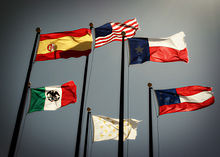 Colonization Flag of the six nations that have had sovereignty over some or all of the current territory of Texas
Colonization Flag of the six nations that have had sovereignty over some or all of the current territory of Texas
The first historical document related to Texas was a map of the Gulf Coast, created in 1519 by Spanish explorer Alonso Álvarez de Pineda. Nine years later, shipwrecked Spanish explorer Álvar Núñez Cabeza de Vacaand his cohort became the first Europeans in Texas.
Cabeza de Vaca reported that in 1528, when the Spanish landed in Texas, “half the natives died from a disease of the bowels and blamed us.” European powers ignored Texas until accidentally settling there in 1685. Miscalculations by René Robert Cavelier de La Salle resulted in his establishing the colony of Fort Saint Louis at Matagorda Bay rather than along the Mississippi River. The colony lasted only four years before succumbing to harsh conditions and hostile natives.
Texas in 1718, Guillaume de L’Isle map, approximate state area highlighted, northern areas indefinite
In 1690 Spanish authorities, concerned that France posed competitive threat, constructed several missions in East Texas. After Native American resistance, the Spanish missionaries returned to Mexico. When France began settling Louisiana, mostly in the southern part of the state, in 1716 Spanish authorities responded by founding a new series of missions in East Texas. Two years later, they created San Antonio as the first Spanish civilian settlement in Texas.
Hostile native tribes and distance from nearby Spanish colonies discouraged settlers from moving to Texas. It was one of New Spain’s least populated provinces. In 1749, the Spanish peace treaty with the Lipan Apache angered many tribes, including the Comanche, Tonkawa, and Hasinai. The Comanche signed a treaty with Spain in 1785 and later helped to defeat the Lipan Apache and Karankawa tribes. With more numerous missions being established, priests led a peaceful conversion of most tribes. By the end of the 18th century only a few nomadic tribes had not converted to Christianity.
When the United States purchased Louisiana from France in 1803, American authorities insisted that the agreement also included Texas. The boundary between New Spain and the United States was finally set at the Sabine River in 1819. Eager for new land, many United States settlers refused to recognize the agreement. Several filibusters raised armies to invade Texas. In 1821, the Mexican War of Independence included the Texas territory, which became part of Mexico. Due to its low population, Mexico made the area part of the state of Coahuila y Tejas.
Stephen F. Austin was the first American empresario given permission to operate a colony within Mexican Texas.
Hoping that more settlers would reduce the near-constant Comanche raids, Mexican Texas liberalized its immigration policies to permit immigrants from outside Mexico and Spain. Under the Mexican immigration system, large swathes of land were allotted to empresarios, who recruited settlers from the United States, Europe, and the Mexican interior. The first grant, to Moses Austin, was passed to his son Stephen F. Austin after his death.
Austin’s settlers, the Old Three Hundred, made places along the Brazos River in 1822. Twenty-three other empresarios brought settlers to the state, the majority of whom were from the United States. The population of Texas grew rapidly. In 1825, Texas had a population of approximately 3,500, with most of Mexican descent. By 1834, Texas had grown to approximately 37,800 people, with only 7,800 of Mexican descent.
Many immigrants openly flouted Mexican law, especially the prohibition against slavery. Combined with United States’ attempts to purchase Texas, Mexican authorities decided in 1830 to prohibit continued immigration from the United States. New laws also called for the enforcement of customs duties angering both native Mexican citizens (Tejanos) and recent immigrants.
The Anahuac Disturbances in 1832 were the first open revolt against Mexican rule and they coincided with a revolt in Mexico against the nation’s president. Texians sided with the federalists against the current government and drove all Mexican soldiers out of East Texas. They took advantage of the lack of oversight to agitate for more political freedom. Texians met at the Convention of 1832 to discuss requesting independent statehood, among other issues. The following year, Texians reiterated their demands at theConvention of 1833.
Republic
Republic of Texas. The present-day outlines of the U.S. states superimposed on the boundaries of 1836–1845
Within Mexico, tensions continued between federalists and centralists. In early 1835, wary Texians formed Committees of Correspondence and Safety. The unrest erupted into armed conflict in late 1835 at the Battle of Gonzales. This launched the Texas Revolution, and over the next two months, the Texians successfully defeated all Mexican troops in the region. Texians elected delegates to the Consultation, which created a provisional government. The provisional government soon collapsed from infighting, and Texas was without clear governance for the first two months of 1836.
During this time of political turmoil, Mexican President Antonio Lopez de Santa Anna personally led an army to end the revolt. The Mexican expedition was initially successful. General Jose de Urrea defeated all the Texian resistance along the coast culminating in the Goliad Massacre. Santa Anna’s forces, after a thirteen-day siege, overwhelmed Texian defenders at the Battle of the Alamo. News of the defeats sparked panic amongst Texas settlers. The newly elected Texian delegates to the Convention of 1836 quickly signed a Declaration of Independence on March 2, forming the Republic of Texas. After electing interim officers, the Convention disbanded. The new government joined the other settlers in Texas in the Runaway Scrape, fleeing from the approaching Mexican army. After several weeks of retreat, the Texian Army commanded by Sam Houston attacked and defeated Santa Anna’s forces at the Battle of San Jacinto. Santa Anna was captured and forced to sign the Treaties of Velasco, ending the war.
While Texas had won their independence, political battles raged between two factions of the new Republic. The nationalist faction, led by Mirabeau B. Lamar, advocated the continued independence of Texas, the expulsion of the Native Americans, and the expansion of the Republic to the Pacific Ocean. Their opponents, led by Sam Houston, advocated the annexation of Texas to the United States and peaceful co-existence with Native Americans. The conflict between the factions was typified by an incident known as the Texas Archive War. Mexico launched two small expeditions into Texas in 1842. The town of San Antonio was captured twice and Texans were defeated in battle in the Dawson Massacre. Despite these successes, Mexico did not keep an occupying force in Texas, and the republic survived. The republic’s inability to defend itself added momentum to Texas’s eventual annexation into the United States.

